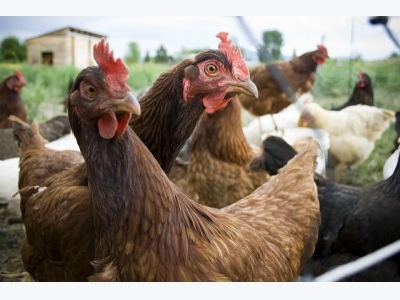Parasite control can reduce hen mortality

A recent PhD study has investigated animal welfare in organic egg production and found an association between hen mortality and the level of parasite infection.
The results of a PhD study carried out at Aarhus University show a clear correlation between mortality and the level of infection with the parasite helminth. Controlling helminth infection can potentially reduce mortality and improve welfare in organic hens.
Mortality during the summer was twice as high on farms with a high level of infection as on farms with a low level of infection.
The aim of the PhD thesis "Animal welfare in organic egg production - with emphasis on mortality and helminth infections" was to investigate animal welfare in organic egg production in Denmark with an emphasis on mortality and helminth infections. The study was conducted on 15 Danish commercial organic farms.
It was investigated if there was an association between helminth infection (Ascaridia galli and Heterakis sp.) and hen mortality at peak of lay. The study also investigated if helminth infections can be predicted using clinical welfare indicators, and which management strategies producers apply to maintain low mortality and control endoparasite infections.
Mortality doubles on farms with high level of infection
The study showed an association between mortality and level of helminth infection. The mortality was twice as high on farms with a high level of infection (average >200 eggs per gram faeces (EPG)) in the summer as on farms with a low level of infection (average ≤ 200 EPG), whereas the mortality on highly-infected farms in the winter did not differ from that on farm with a low level of infection.
214 individual hens from 12 flocks were assessed clinically at the peak of lay and end of lay and the level of helminth infections were determined at the end of production. The prevalence of injuries on the skin, feet and comb were low.
Analysis of the association between plumage condition, keel bone deformities, production system (single- or multi-tiered) and level of endoparasitic infection levels showed that the level of helminth infection was correlated to the plumage condition on the back at end of lay.
Hens with a good plumage condition on the back had a higher incidence of helminth infections compared to hens with a poor plumage condition on the back. This indicates that the hens with a good plumage condition spent more time in area with a higher infection risk. This could be the outdoor area or the litter area.
Three important themes for maintaining low mortality
Qualitative interviews showed that producers see the following three themes as important for maintaining low mortality:
• Quality of the pullets (uniformity of the pullets and a good start after placement in the egg production house)
• Management and time spent (daily routines, time spent in the henhouse and time for unexpected matters)
• Feed (quality and quantity of the feed and water).
In relation to controlling helminth infection, the identified strategies were either not to test endoparasite infection levels or to test endoparasite infection levels with regular or irregular time intervals, which led to deworming as necessary. The producers believed that the management initiative related to mortality also had a positive effect on helminth infections and vice versa.
Control of helminth infection can potentially reduce mortality and improve the welfare of hens with a good plumage condition, as these hens have the highest incidence of helminth infections. Producers lack knowledge of alternatives to deworming, i.e. alternative ways to control endoparasites, which could potentially could improve animal welfare in organic egg production. More research on preventing endoparasitic infections is therefore necessary.
Related news
Tools

Phối trộn thức ăn chăn nuôi

Pha dung dịch thủy canh

Định mức cho tôm ăn

Phối trộn phân bón NPK

Xác định tỷ lệ tôm sống

Chuyển đổi đơn vị phân bón

Xác định công suất sục khí

Chuyển đổi đơn vị tôm

Tính diện tích nhà kính

Tính thể tích ao



 Can fly larvae replace synthetic methionine in organic…
Can fly larvae replace synthetic methionine in organic…  Project to prevent erysipelas in organic poultry
Project to prevent erysipelas in organic poultry